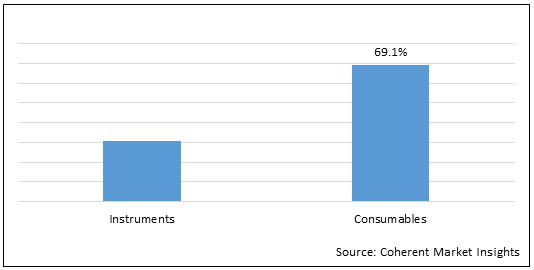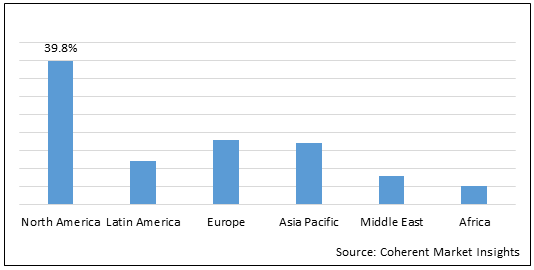Cell lysis is the first step of protein extraction, which is further used for different applications such as enzyme engineering and protein labelling. Furthermore, cell lysis is also an important step to study protein -protein interaction, which supports growth of cell lysis market. Players in the global cell lysis market are focusing on investing in research and development, to introduce advanced products used in cell lysis process. Furthermore, increasing demand for cell-based therapy for treatment purpose of cancer is also expected to augment growth of the cell lysis market.
Global cell lysis market is estimated to be valued at US$ 3,781.33 million in 2022 and is expected to exhibit a CAGR of 8.6% during the forecast period (2022-2030).
Figure 1.Global Cell Lysis Market Share (%), by Product Type, 2022

To learn more about this report, Request sample copy
Increasing research and development in the field of proteomics and genomics are expected to drive growth of the cell lysis market
Increasing research and development in the field of proteomics and genomics and high prevalence of infectious diseases and cancer are the major factors driving growth of the cell lysis market. Advancements and approvals for cell-based therapies are expected to support growth of cell lysis market. For instance, in May 2022, Novartis AG, a global healthcare company, announced that the US Food and Drug Administration (FDA) had granted accelerated approval for Kymriah (tisagenlecleucel) for the treatment of adult patients with relapsed or refractory (r/r) follicular lymphoma (FL) after two or more lines of systemic therapy. Kymriah is now FDA approved in three indications and remains the only CAR-T cell therapy approved in both adult and pediatric settings.
Cell Lysis Market Report Coverage
| Report Coverage | Details | ||
|---|---|---|---|
| Base Year: | 2021 | Market Size in 2022: | US$ 3,781.33 Mn |
| Historical Data for: | 2017 to 2020 | Forecast Period: | 2022 to 2030 |
| Forecast Period 2022 to 2030 CAGR: | 8.6% | 2030 Value Projection: | US$ 7,335.40 Mn |
| Geographies covered: |
|
||
| Segments covered: |
|
||
| Companies covered: |
Becton, Dickinson and Company, Thermo Fisher Scientific Inc., Merck KgaA, QIAGEN, Roche Molecular Systems, Inc., Bio-Rad Laboratories, Inc., Cell Signaling Technology, Inc., and Qsonica |
||
| Growth Drivers: |
|
||
| Restraints & Challenges: |
|
||
Uncover macros and micros vetted on 75+ parameters: Get instant access to report
Figure 2.Global Cell Lysis Market Share (%), by Region, 2022

To learn more about this report, Request sample copy
High prevalence of infectious diseases and cancer are expected to drive market growth during the forecast period.
Rising prevalence of cancer is expected to drive market growth over the forecast period. Breast cancer is the second most common type of cancer in the U.S., after skin cancer. Breast cancer can occur both, in men and women. However, it is mostly found among females and the male occurrence of breast cancer is very rare. For instance, according to the data provided by Breastcancer.org, in March 2022, an estimated 287,850 new cases of invasive breast cancer are expected to be diagnosed in women in the U.S., along with 51,400 new cases of non-invasive (in situ) breast cancer in 2022.
Global Cell Lysis Market– Impact of Coronavirus (COVID-19) Pandemic
Since the COVID-19 virus outbreak in December 2019, the disease has spread to over 100 countries across the globe and the World Health Organization had declared it a public health emergency on January 30, 2020.
COVID-19 has affected the economy in three main ways: by directly affecting production and demand of drugs and vaccines by creating disruptions in distribution channels, and through its financial impact on firms and financial markets. Due to nationwide lockdowns, several countries, such as China, India, Saudi Arabia, UAE, Egypt, and others, are facing problems with regard to the transportation of drugs and vaccines from one place to another.
However, the COVID-19 pandemic had a positive impact on the global cell lysis market, owing to increased research and development activities for developing treatment options for the COVID-19 infection and because of the application of cell lysis in real-time reverse transcription–polymerase chain reaction (RT-PCR) tests. Lysing enzymes are used to open up the cell to obtain DNA along with other macromolecules for genetic experiments. Cell lysis can help to study the proteins, DNA and other organelles of the cell, due to which it can be used to study the features of the virus and guide the researchers develop an appropriate treatment to fight against the virus.
Global Cell Lysis Market: Key Developments
In May 2022, Tethis S.p.a., a privately held company focused on bio and nanotechnology fields to develop and commercialize in vitro diagnostic devices, announced the release of See.d, the first universal blood sample preparator for liquid biopsy analysis. All sample preparation steps of See.d blood sample preparator are automated: separation of plasma from the cellular fraction, red blood cells lysis and removal, white blood cells dispensation and fixation on SBS slides, and plasma recovery in tubes.
In November 2021, One BioMed, a molecular life science company, announced the launch of the Xceler8 platform for high-yield extraction and purification of nucleic acids from biological samples. Pre-filled with all the necessary reagents, X8 cartridge kits, powered by the one-touch instrument and its touchscreen tablet, automates all nucleic acid extraction steps, including cell lysis, capture, washing and elution in about 30 minutes.
Global Cell Lysis Market: Restraint
The major factor that hinders growth of the global cell lysis market is high cost of cell based research. High cost of cell based research, owing to high expenditure in research and development for CAR-T cell therapy may hamper the growth of market. For instance, the U.S. Food and Drug Administration approved chimeric antigen receptor (CAR) T-cell therapy tisagenlecleucel (Kymriah) of Novartis AG, a global healthcare company, which is priced at US$ 475,000 for single infusion for pediatric and young adult patients with B-cell precursor acute lymphoblastic leukemia. Moreover, this cost does not include pre-infusion treatment costs, drug administration costs, hospitalization costs, and costs associated with adverse events and follow-up care.
Key Players
Major players operating in the global cell lysis market include Becton, Dickinson and Company, Thermo Fisher Scientific Inc., Merck KgaA, QIAGEN, Roche Molecular Systems, Inc., Bio-Rad Laboratories, Inc., Cell Signaling Technology, Inc., and Qsonica.
Share
Share
Missing comfort of reading report in your local language? Find your preferred language :
Transform your Strategy with Exclusive Trending Reports :
Frequently Asked Questions
Select a License Type
Credibility and Certifications

860519526

9001:2015
27001:2022


Joining thousands of companies around the world committed to making the Excellent Business Solutions.
View All Our Clients
US Reciprocal Tax Impact Analysis On Cell Lysis Market
Stay updated on tariff changes with expert insights and timely information